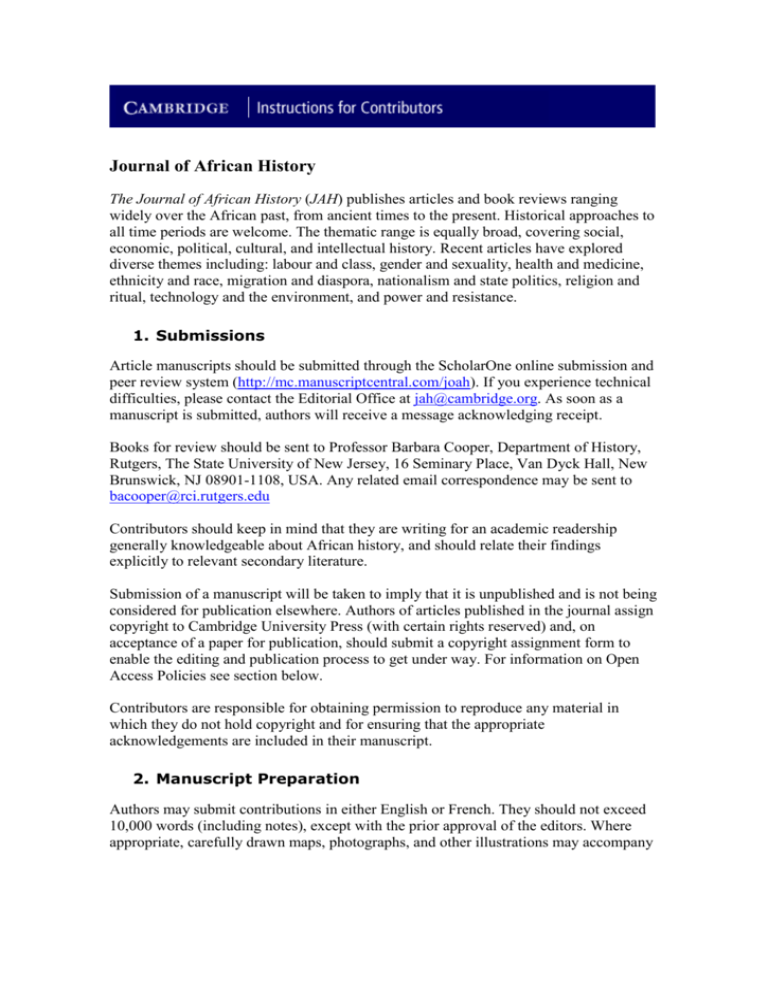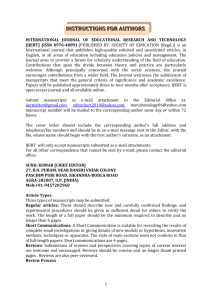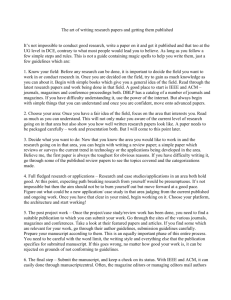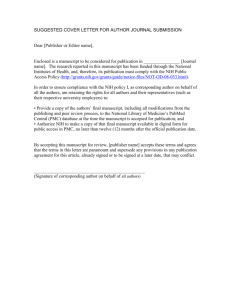
Journal of African History
The Journal of African History (JAH) publishes articles and book reviews ranging
widely over the African past, from ancient times to the present. Historical approaches to
all time periods are welcome. The thematic range is equally broad, covering social,
economic, political, cultural, and intellectual history. Recent articles have explored
diverse themes including: labour and class, gender and sexuality, health and medicine,
ethnicity and race, migration and diaspora, nationalism and state politics, religion and
ritual, technology and the environment, and power and resistance.
1. Submissions
Article manuscripts should be submitted through the ScholarOne online submission and
peer review system (http://mc.manuscriptcentral.com/joah). If you experience technical
difficulties, please contact the Editorial Office at jah@cambridge.org. As soon as a
manuscript is submitted, authors will receive a message acknowledging receipt.
Books for review should be sent to Professor Barbara Cooper, Department of History,
Rutgers, The State University of New Jersey, 16 Seminary Place, Van Dyck Hall, New
Brunswick, NJ 08901-1108, USA. Any related email correspondence may be sent to
bacooper@rci.rutgers.edu
Contributors should keep in mind that they are writing for an academic readership
generally knowledgeable about African history, and should relate their findings
explicitly to relevant secondary literature.
Submission of a manuscript will be taken to imply that it is unpublished and is not being
considered for publication elsewhere. Authors of articles published in the journal assign
copyright to Cambridge University Press (with certain rights reserved) and, on
acceptance of a paper for publication, should submit a copyright assignment form to
enable the editing and publication process to get under way. For information on Open
Access Policies see section below.
Contributors are responsible for obtaining permission to reproduce any material in
which they do not hold copyright and for ensuring that the appropriate
acknowledgements are included in their manuscript.
2. Manuscript Preparation
Authors may submit contributions in either English or French. They should not exceed
10,000 words (including notes), except with the prior approval of the editors. Where
appropriate, carefully drawn maps, photographs, and other illustrations may accompany
the text: such illustrations are only appropriate where they will specifically enhance
understanding of the text. An abstract of the contents of the article, not exceeding about
150 words, should be included at the head of the main text immediately after the title.
Contributors should seek clarity, brevity, and simplicity of expression and avoid long
sentences and unduly lengthy or short paragraphs. They should closely observe the
conventions set out below (‘Format and Style’ and ‘Notes’).
Article manuscripts should be prepared in a widely used word-processing format,
preferably MS Word. They should be double-spaced throughout. Lines beginning new
paragraphs should be indented, except at the beginning of a section. Ample margins (at
least one inch left and right, one and one-half inches top and bottom) must be left, and
all pages should be numbered.
In order to facilitate anonymous peer review, manuscripts submitted for consideration
should not bear the name of the author, nor should they have notes/acknowledgements
that make the author’s identity obvious. Authors may, of course, add such
acknowledgements if the manuscript is accepted for publication.
Maps should be prepared where the topography is important for an understanding of the
text. Maps should if possible be camera-ready and show all relevant information, but
only such information as is mentioned in the text. Photographs should specifically
enhance the text and carry full captions and attributions. Images should not be
embedded as Word picture files in the text, but should be supplied in their original
graphic format (JPG, TIFF, etc.).
English Language Editing Services
Authors, particularly those whose first language is not English, may wish to have their
English-language manuscripts checked by a native speaker before submission. This is
optional, but may help to ensure that the academic content of the paper is fully
understood by the editor and any reviewers. We list a number of third-party services
specialising in language editing and/or translation, and suggest that authors contact as
appropriate:
http://journals.cambridge.org/action/stream?pageId=8728&level=2&menu=Authors&pa
geId=3608
Please note that the use of any of these services is voluntary, and at the author's own
expense. Use of these services does not guarantee that the manuscript will be accepted
for publication, nor does it restrict the author to submitting to a Cambridge published
journal.
3. Format and Style
Spelling (in English) may follow either British or American convention but must be
consistent. African words and names should conform to the orthography of the
International African Institute. In referring to people, Bantu prefixes should normally be
omitted: thus ‘Luganda’, ‘Buganda’, but ‘a Ganda’, ‘the Ganda’.
2
Quotations of more than forty words or so should begin on a new line, indented from
the left-hand margin, without inverted commas and preceded and followed by a single
blank line. Any use of italics in quotations, whether original or added, should be noted
with the source. Material inserted within a quotation is to be placed in square brackets.
Where shorter quotations are used, these should come within the text and single inverted
commas are to be used. Double inverted commas should only be used in the rare
instance of a quotation within a quotation.
Other Text Conventions
1. Acknowledgements should be set as an asterisked footnote attached to the title of
the paper.
2. Subheadings should be centered and placed in all capitals.
3. Full stops (periods) should be followed by a single space.
4. The serial comma (as in red, white, and blue) should be used.
5. Contractions (such as ‘Dr’ and ‘edn’) should not be followed by a full stop.
However, abbreviations (such as ‘Prof.’, ‘ed.’, and ‘vol.’) and their plurals (‘eds.’,
‘vols.’) should be followed by a full stop.
6. Italics should be used only for the names of publications and for words in languages
other than English. Foreign words should be used only when necessary, and then
only with a translation in parentheses.
7. Ibid. and c. should be set in italics, with a full stop. E.g. and i.e. may be used in the
footnotes but not in the main text.
8. Possessive apostrophes should be followed by ‘s’ after names ending in s.
9. Dates should be written as ‘23 February 2010’ (or ‘Feb.’ in source references). Use
BCE and CE, not BC and AD. Date spans should be elided as much as possible (‘1848–
9’, but note ‘1911–12’); the exception to this is BCE date spans, which should always
be given in full. Write ‘twentieth century’, rather than ‘20th century’. When used as
an adjective, please hyphenate so, for example, ‘twentieth-century challenges’.
10. Numbers should be elided as 57–63, 208–9, but 11–13. Spell out numbers up to ten
and multiples of ten up to one hundred (‘seven’, ‘twenty’, but ‘25’, ‘127’, ‘10,000’).
Where there is a mixture of numbers normally written in words and figures, give all
numbers in figures. Figures should be used for units of measurement, percentages
(to be shown in the form ‘7 per cent’, not ‘7%’), and any number that includes a
decimal point.
11. Illustrations (including maps and graphs) should be referred to as ‘Fig. 1’, ‘Figs. 6
and 7’, etc.
4. Notes
Notes should be footnotes not endnotes. They should be numbered consecutively
throughout the article (1, 2, 3 not I, II, III) and typed double-spaced. Footnotes should
be placed only at the end of sentences and paragraphs. There should be no separate
bibliography. The following footnote forms should be used:
3
BOOKS:
First reference: C. Wrigley, Kingship and State: The Buganda Dynasty (Cambridge,
1996), 192–5.
Subsequent reference: Wrigley, Kingship, 11–12.
If an edition number is necessary, set it in the brackets with the publication details, e.g.
‘(2nd edn, London, 1992)’
CHAPTERS IN BOOKS:
First reference: A. M. Howard, ‘Nodes, networks, landscapes, and regions: reading the
social history of tropical Africa, 1700s–1920’, in A. M. Howard and R. M. Shain (eds.),
The Spatial Factor in African History: The Relationship of the Social, Material, and
Perceptual (Leiden, 2005), 21–5.
Subsequent reference: Howard, ‘Nodes’, 17.
JOURNAL ARTICLES
First reference: D. L. Schoenbrun, ‘A past whose time has come: historical context and
history in the Great Lakes region’, History and Theory, 32:4 (1993), 32–56.
Subsequent reference: Schoenbrun, ‘A past’, 32–3.
ARCHIVAL AND UNPUBLISHED MATERIALS
The identity and location of each archive must be fully spelled out where it is first cited
and placed at the start of the citation, but an abbreviated reference may be used thereafter.
First reference: Tanzania National Archives, Dar es Salaam (TNA) 61/701/1, letter from
Secretary, Tanganyika Muslim Jazz Band Club to Provincial Commissioner, Eastern
Province, 3 Apr. 1940.
Subsequent reference: TNA 61/701/1, letter from Secretary, Tanganyika Muslim Jazz
Band Club to Provincial Commissioner, Eastern Province, 3 Apr. 1940.
First reference: Rhodes House, Bodleian Library, Oxford (RH) MS Africa s. 17, 4, J.
Roscoe and A. Kaggwa, ‘Enquiry into native land tenure in the Uganda Protectorate’,
1906.
Subsequent reference: RH MS Africa s. 17, 4, J. Roscoe and A. Kaggwa, ‘Enquiry into
native land tenure in the Uganda Protectorate’, 1906
THESES
First reference: M. Taylor, ‘Life, land and power: contesting development in northern
Botswana’ (unpublished PhD thesis, University of Edinburgh, 2000), 79–81.
Subsequent reference: Taylor, ‘Life’, 23.
INTERVIEWS
First reference: Interview with Bakari Kamian, Bamako, 11 July 2002.
Subsequent reference: Interview with Bakari Kamian.
Ibid. should be used to refer to an immediately preceding citation of a title. Loc. cit., op.
cit., and idem. should not be used. Do not abbreviate periodical titles. ‘Et al.’ should
only be used where there are more than four authors/editors, and should not be
italicized. Volume numbers for books should be given in Roman numerals (‘II’, ‘IV’,
etc.) and not preceded by ‘vol.’
5. Figures and Artwork
1.
2.
3.
4.
5.
6.
Line artwork (graphs) should be saved at 1200dpi and ideally saved as TIFF or EPS
files.
Halftones (photographs) should be saved at 300dpi and ideally saved as TIFF files.
All figures must include an accompanying figure legend. Photographs should
include reference to sources. Figure legends to be included at the end of the Word
document after the references.
All figures must be cited in the text.
Figures to be supplied at approximately the size of reproduction (maximum 120mm
x160mm)
The print version of the journal does not support colour figures, therefore please
indicate if you wish colour figures to be published online in colour.
Authors wishing to have their artwork reproduced in colour when printed will be subject
to a charge of £200 per image, up to a maximum of £1,000.
Please note that colour artwork may be published in colour in the online version at no
additional cost and reproduced in black and white in the print issue, subject to files
being of sufficient quality.
For full details, refer to the guidelines here http://journals.cambridge.org/artworkguide
6. Proofs
Typographical or factual errors only may be changed at proof stage. The publisher
reserves the right to charge authors for correction of non-typographical errors.
7. Offprints
Authors will receive a PDF of their article on publication. Authors requiring offprints
may purchase these from the publisher if ordered at proof stage.
8. Open Access Policies
Please visit http://journals.cambridge.org/openaccess for information on our open access
policies, compliance with major funding bodies, and guidelines on depositing your
manuscript in an institutional repository.
Last updated 9th October 2014
5








